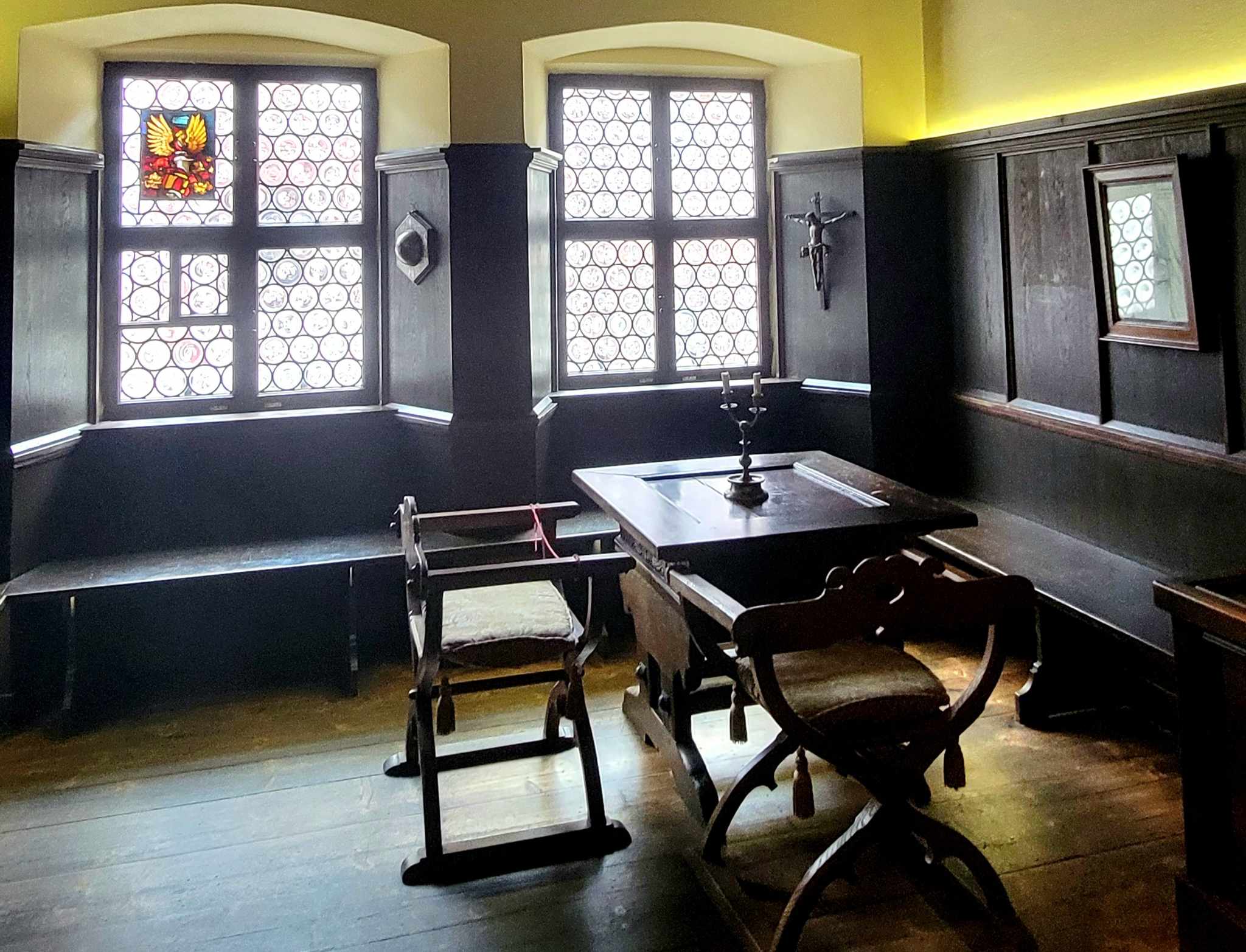Here’s the ultimate self-guided tour for all the best Albrecht Dürer sites in Nuremberg, Germany – where to see his art, his home, his legacy, and his journey from birth to death in the city that has loved him since the beginning.
Albrecht Dürer and the German city of Nuremberg are inseparable. Though he traveled extensively across Europe and gained considerable fame in Italy and the Netherlands, he was born, built his career, set down his roots, and left a lasting mark in the city of his birth.
Walking through the Nuremberg (Nürnberg) today, you’ll find traces of the great Renaissance master artist everywhere—from his former home and final resting place to statues, original artworks, and even an unexpected (and slightly creepy) tribute to his famous hare.
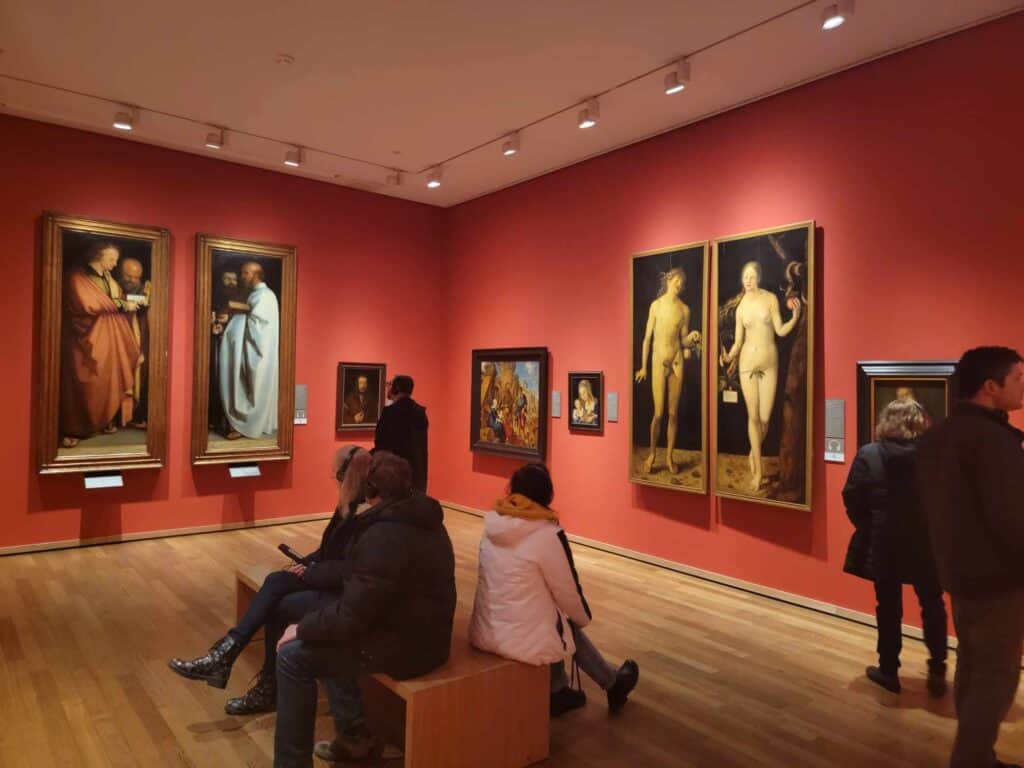
I’ve been a Dürer fan for as long as I can remember. A reproduction of his Young Hare hung on the living room wall of my childhood home. I had a stuffed rabbit named Albrecht, and a book on Dürer’s works from my father was a prized possession. Yes, I was an art nerd as a child, and visiting Nuremberg gave me goosebumps from beginning to end. There were Durer “Easter eggs” to find around every corner, in every gift shop, and even on street signs. Nuremberg is without a doubt, his city – even more than 500 years after his death.
This guide will take you through the best places in Nuremberg to experience Dürer’s legacy, and walk in his footsteps—whether you want to see where he was born, visit his grave, or find streets and landmarks named in his honor (and even one for his wife, Agnes!). Plus, we’ll highlight top museums worldwide where you can see his masterpieces if Nuremberg isn’t your final stop.
Here’s how you can follow in Dürer’s footsteps, and have an awesome tour of Nuremberg!
1) Albrecht Dürer House Museum (Albrecht-Dürer-Haus)

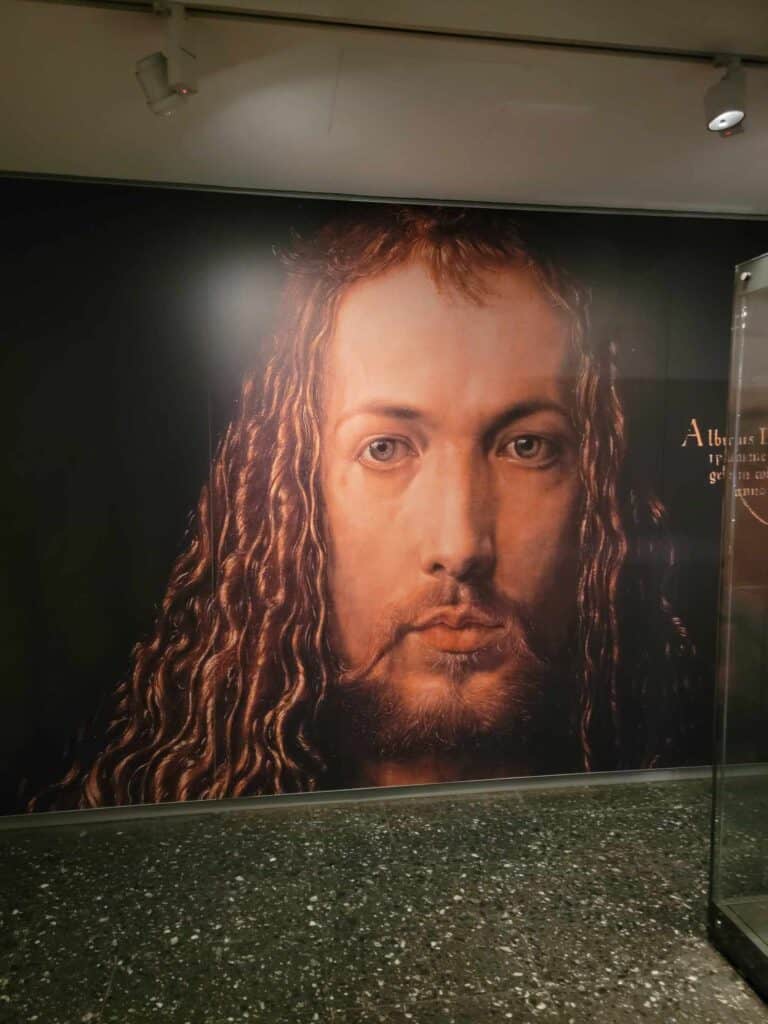
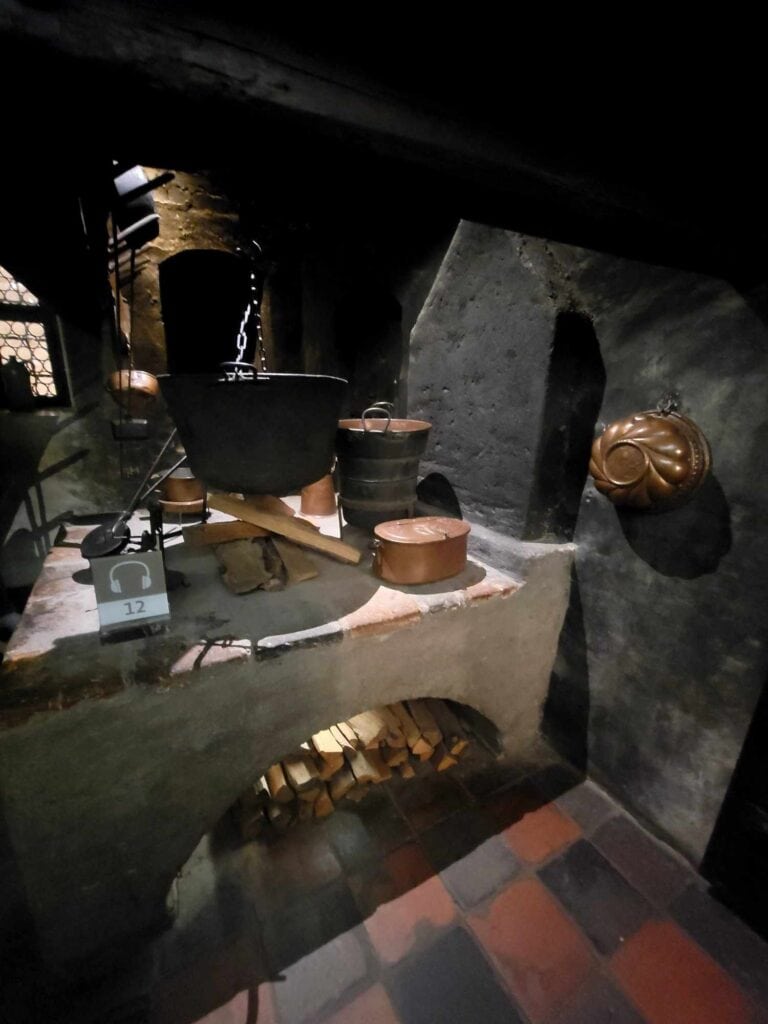
History and Significance
It’s one thing to see the works of the master in a museum, but fully another to be able to walk through his actual house, see his studio and his kitchen, look out the window at the view of the city walls he saw every day… it was just crazy cool. And the fact that Dürer’s house was one of the very few buildings in Nuremberg’s Old Town to have survived the devastating bombing raids during World War II is such an extraordinary piece of luck!
Albrecht Dürer worked and lived in the house with his wife Agnes, and his mother Barbara, from 1509 until his death in 1528. For the non-art nerds, Dürer was one of the most influential artists and thinkers of the Renaissance, famously celebrated across Europe for his incredibly detailed woodcuts, engravings, and paintings, as well as for his contributions to mathematical perspective. He really did shape much of early modern European art, and it’s a thrill to be able to hang out in his house.
Restoration
The building itself has been beautifully preserved and restored to reflect the time period when Dürer lived there. The house underwent a major restoration project in the 1970s, and today it is one of the most well-preserved examples of Renaissance-era architecture in Nuremberg.
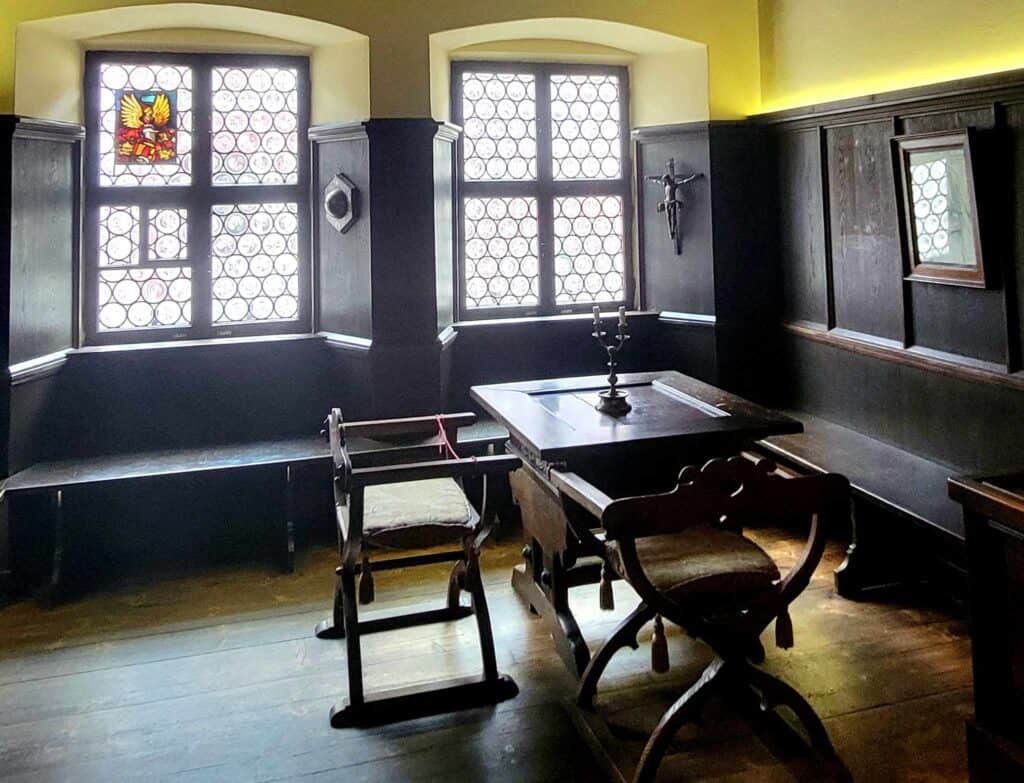
Miraculously, the timber frame you can see on the outside of the house is original to the structure and was preserved because it had at one time been completely plastered over, saving the timbers from weathering and damage.
What You Can Expect Visiting the Albrecht Dürer House Museum
You’ll be able to see rooms recreated to look as they might have during Dürer’s lifetime. There was an addition made to the house in the 1970s which covered what used to be a small courtyard and now features a gallery of reproductions of his works.
The reproductions were commissioned to be painted by incredibly talented artists and honestly, you wouldn’t know the difference. It’s pretty incredible and gives much more of a feeling of authenticity than if they had chosen printed copies.
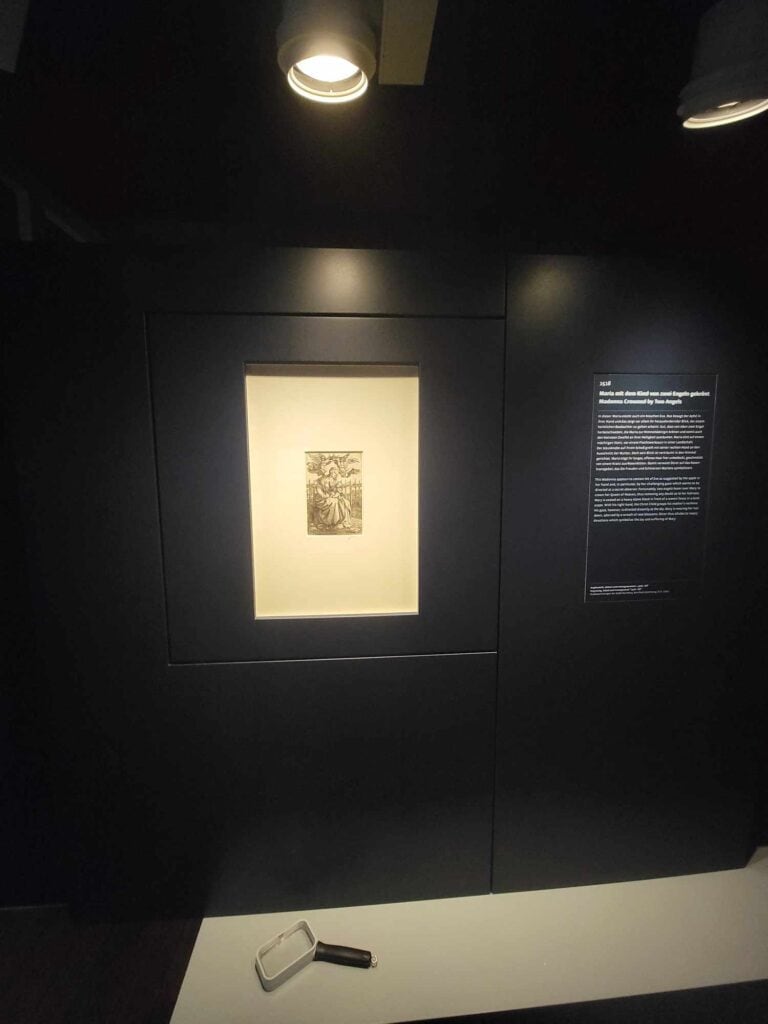
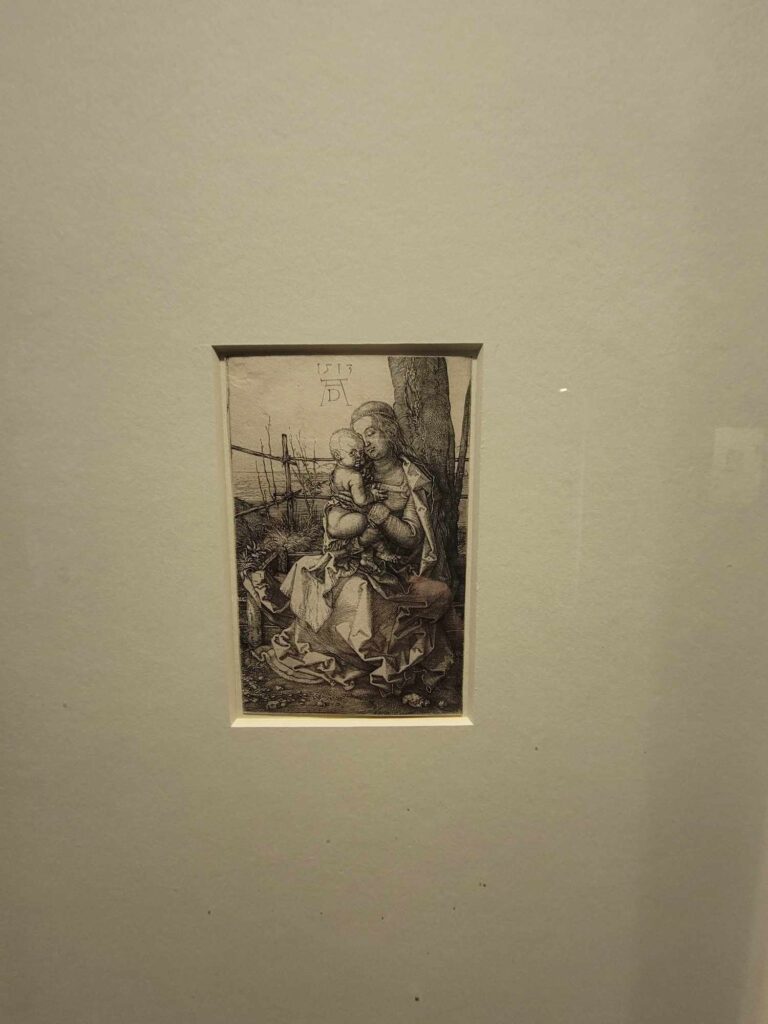
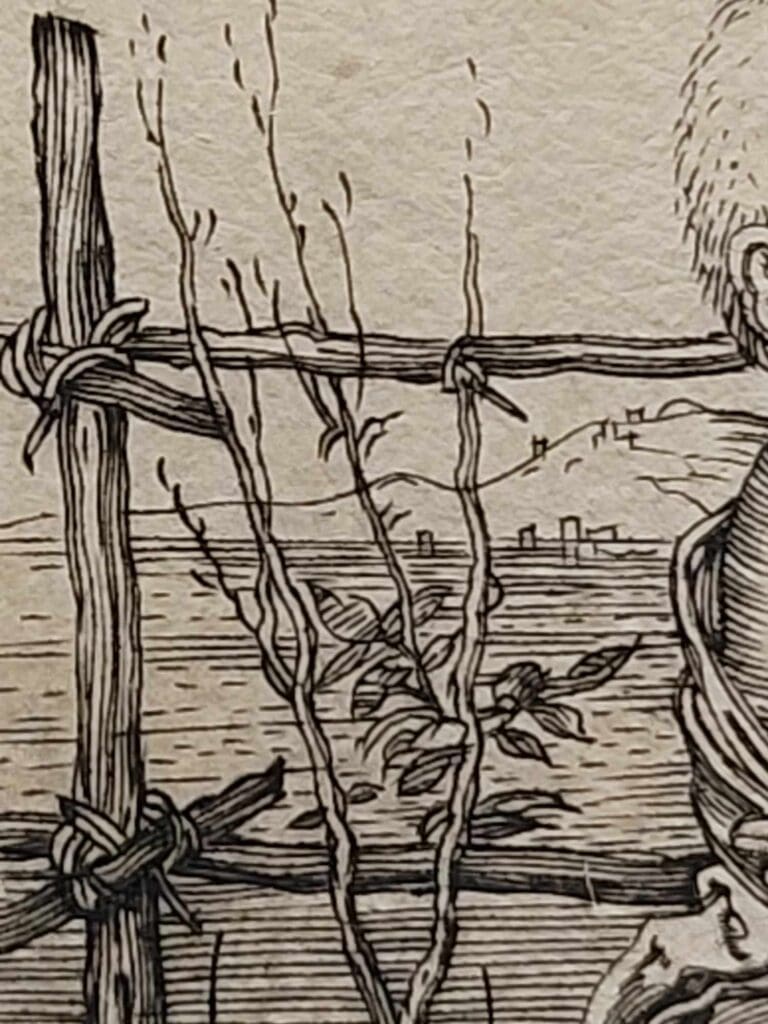
There’s also an exhibit of Dürer’s engravings on the top floor. You’ll be provided with magnifying glasses at each artwork so you can really get up close and examine the incredibly fine detail he was known for.
There is also an opportunity in the museum to watch and participate in printmaking in action!
There’s also a great gift shop which you’ll find right across the street, and it sells everything from prints and postcards of Dürer’s artwork, to fun and kitschy souvenirs mostly centering on his famous painting of the hare, and his woodcut of a rhinoceros. I filled a bag!
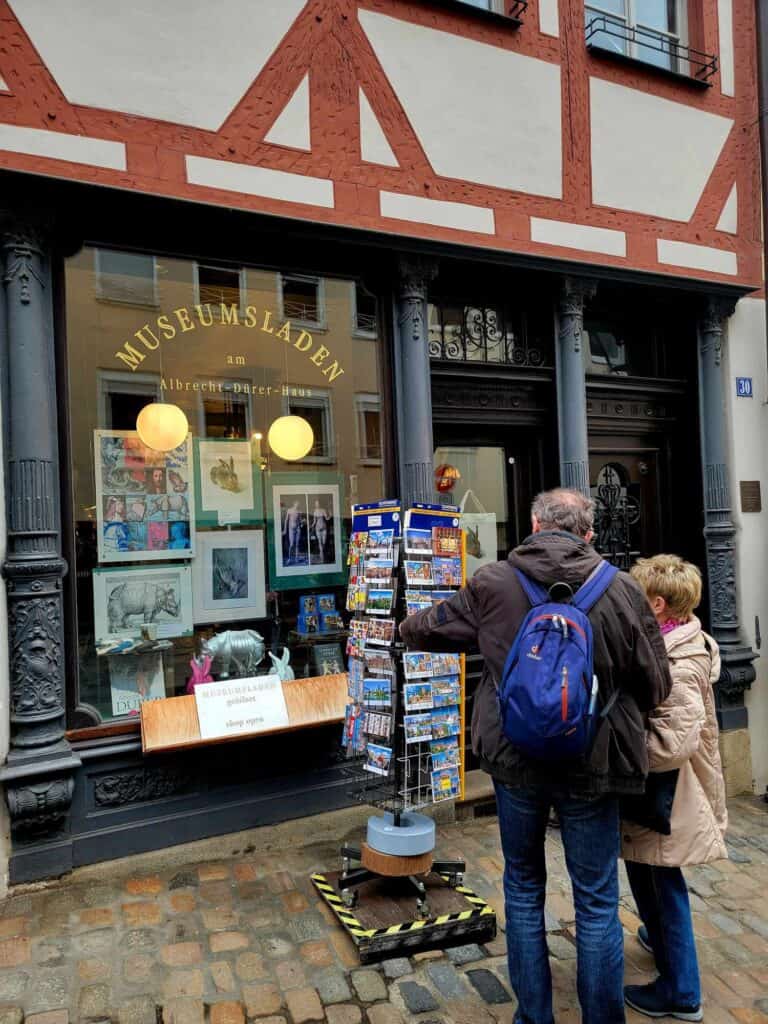
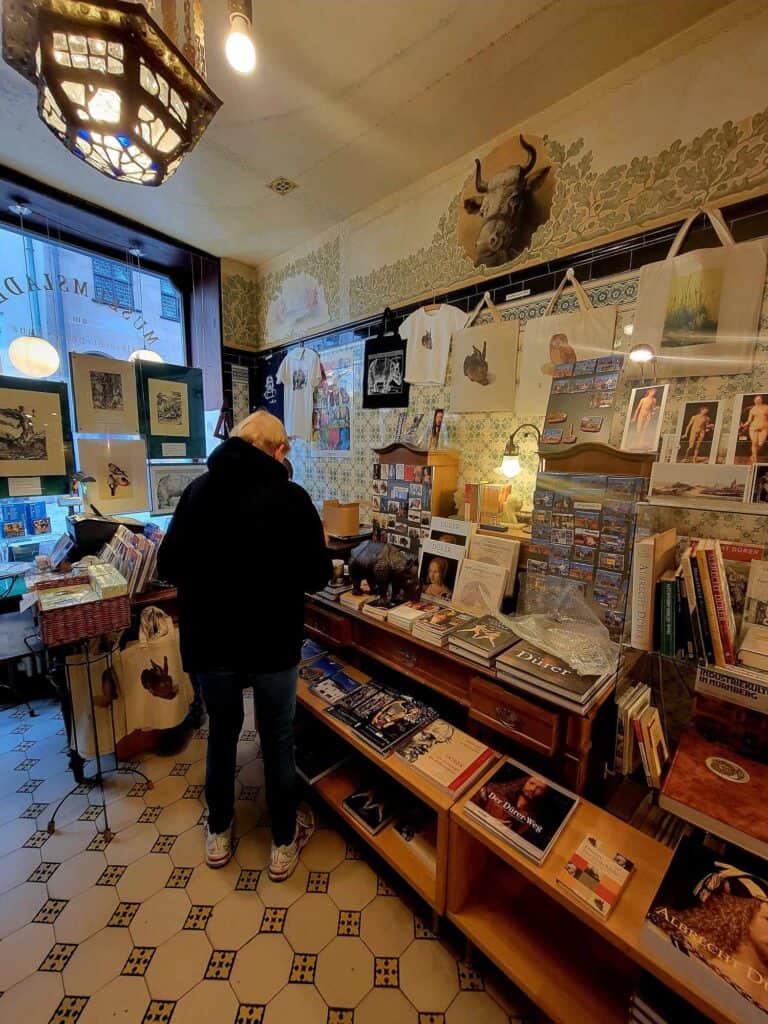
Visiting Information for Albrecht Dürer House Museum
Opening Hours:
- Tuesday to Friday: 10:00 AM – 5:00 PM
- Saturday and Sunday: 10:00 AM – 6:00 PM
- July through September and during the Christmas Market in December, the museum is also open on Monday 10:00 AM – 5:00 PM
Admission Prices (including an audioguide):
- Adults (18+): €7.50
- 4-18 years old, students: €2.50
- With Nuremberg Pass: €2.00
Audio Tours: There’s a really good audioguide with headphones available in English, German, French, Italian, Spanish, Japanese, and Russian at the ticket counter. The tour takes about 40 minutes. You can pause it if you want to linger somewhere.
Facilities: The museum has nice restrooms downstairs.
Accessibility: The museum is accessible to visitors with mobility impairments.
For the most accurate and up-to-date information, check out the official website.
2) Dürer’s Masterpieces in the Germanisches Nationalmuseum
Kartäusergasse 1, 90402 Nürnberg
As an art lover, the Germanisches Nationalmuseum will be the absolute highlight of your visit to Nuremberg. The museum is home to a stunning collection of his original works, and many more collections worth the time to explore.
Overview of Dürer’s Artworks in the Museum
The Germanisches Nationalmuseum showcases some really beautiful pieces by Dürer including huge and impressive portraits of the Emperors Charlemagne and Sigismund, and a portrait of his mother, Barbara who lived with him in her later life.
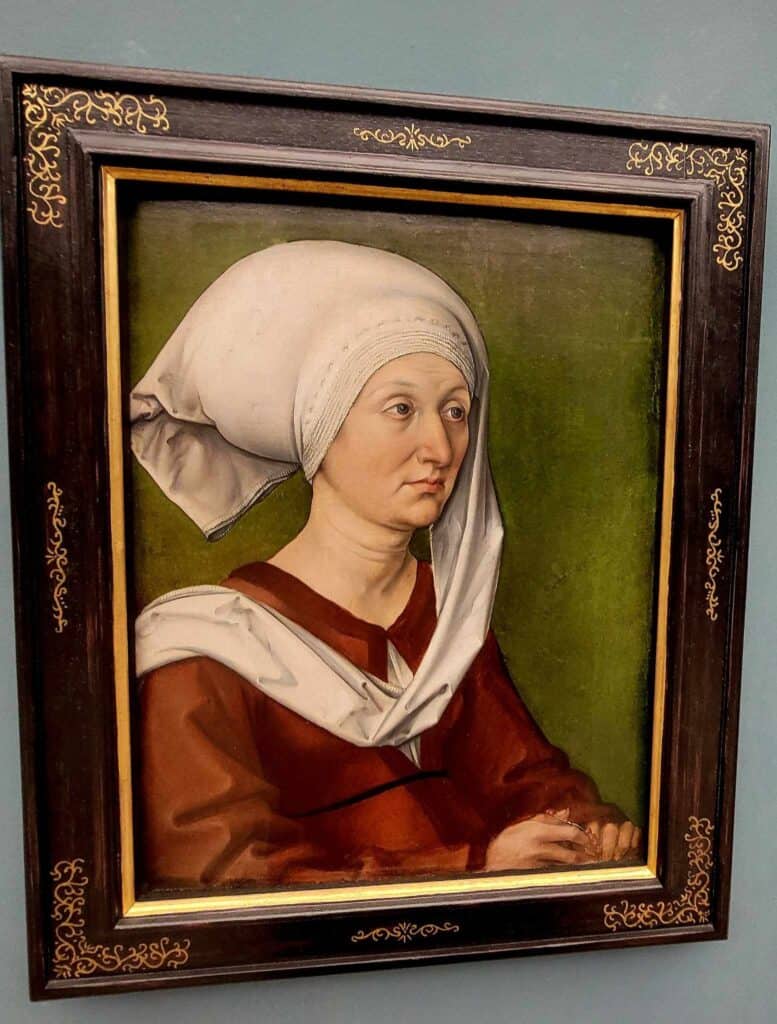
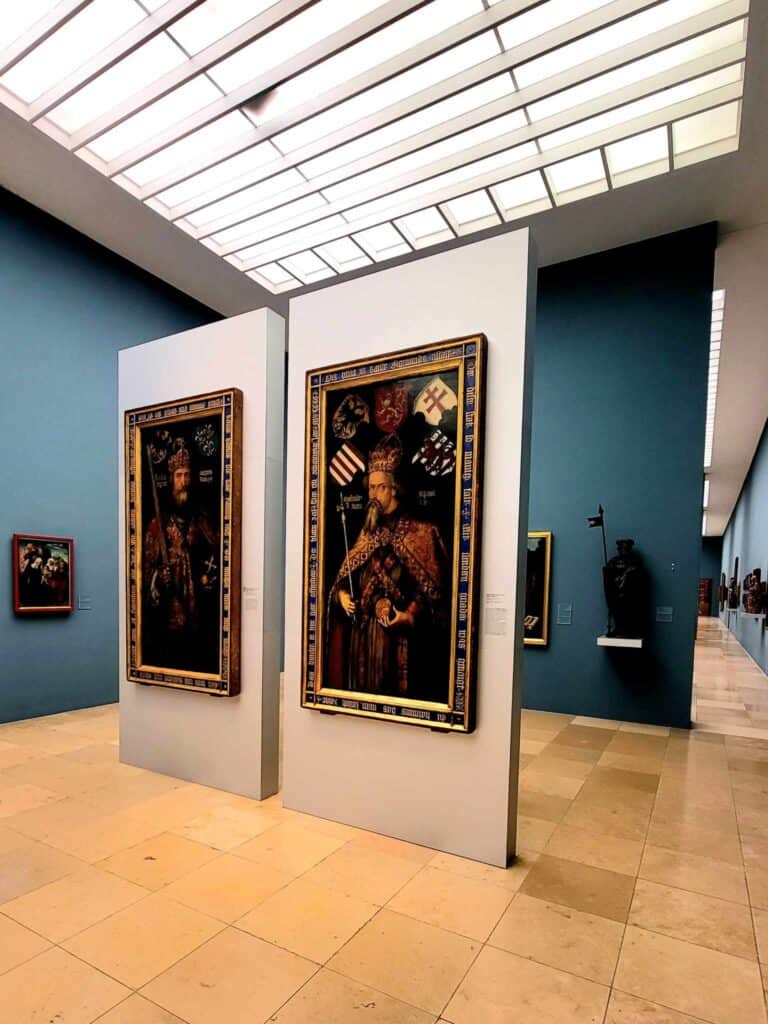
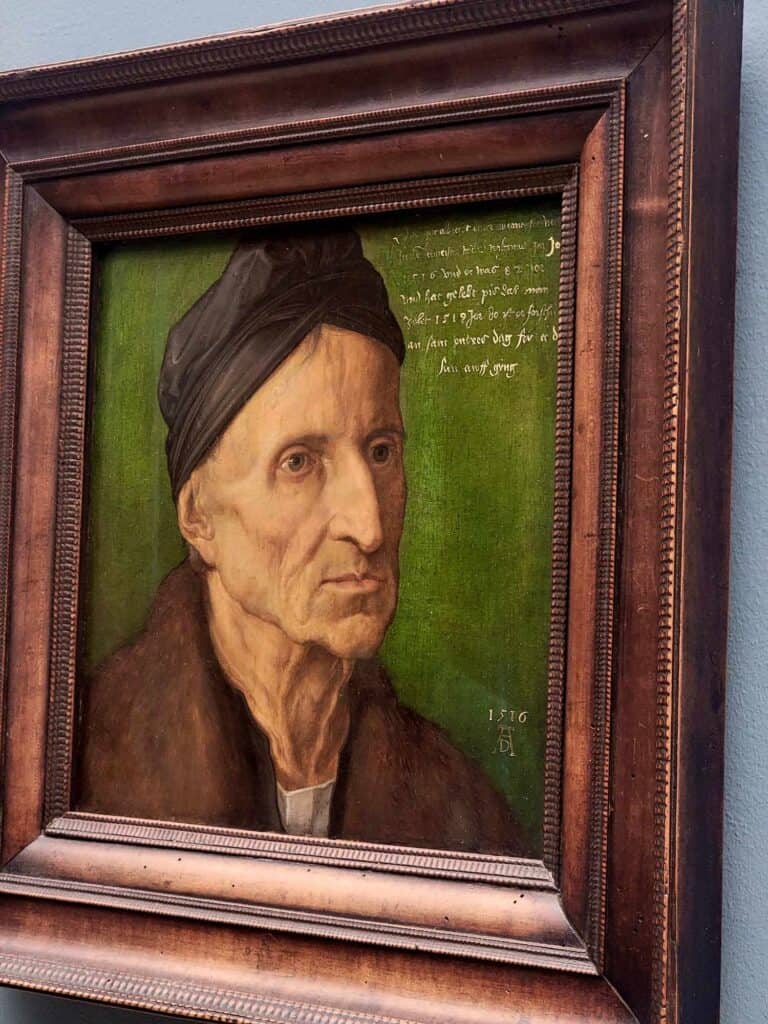
The Museum’s Collection Includes:
Picture of Barbara Dürer, around 1490; Weeping of Christ, around 1498/1500; Heracles in the fight against the Stymphal birds, 1500; Portraits of Emperor Charlemagne and Emperor Sigismund, 1512/13; portrait of the painter Michael Wolgemut. 1516; Draft of the portrait of Emperor Maximilian I. 1518/19.
Visiting Information for the Germanisches National Museum
Hours: Tuesday–Sunday, 10:00 AM – 6:00 PM (Wednesdays open until 8:30 PM)
Admission: €8 for adults, free on Wednesdays after 6:00 PM
Getting There: The museum is centrally located, near Hauptbahnhof (Central Station) and is an easy walk from the historical center.
3) Albrecht Dürer Monument in Albrecht-Dürer-Platz
Albreche-Dürer-Platz, Nuremberg
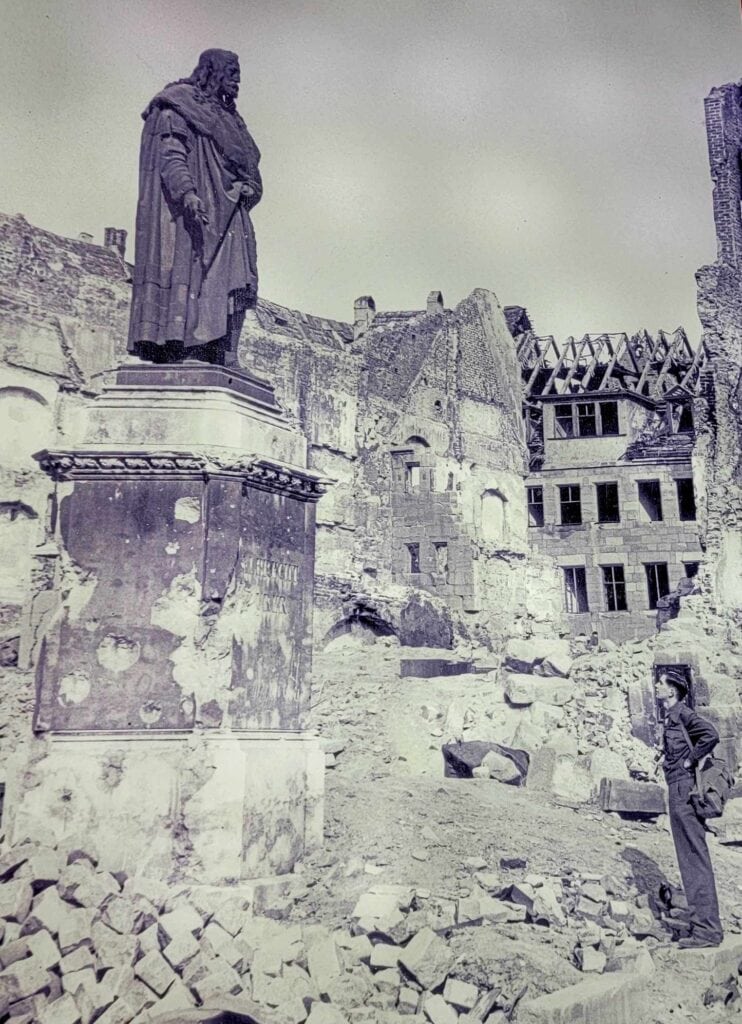

The imposing and impressive Albrecht Dürer Monument is a bronze statue located in Albrecht-Dürer-Platz which is just up the hill from St. Sebaldus Church. Erected between 1837 and 1840, the statue was designed by the renowned sculptor Christian Daniel Rauch and cast by Jacob Daniel Burgschmiet. It is almost 10 feet (3 meters) tall, and shows Dürer in a cloak, with his trademark beard and long curly locks, holding a brush, stylus, and laurel branch.
During World War II, the monument suffered some damage, mostly to its original pedestal. Photos just after the war show Dürer looking over the ruins of Nuremberg like a sole survivor. Post-war restoration efforts included the creation of a new pedestal, which is not as nice as the original, but it works.
To me, seeing the post-war vs. modern day monument makes this one of the most evocative Albrecht Dürer sites in Nuremberg.
4) Agnesgasse – A Tribute to Agnes Dürer
You will notice when you walk along Albrecht Dürer Platz near the monument, a street that runs perpendicular to it, connecting in the center. It is called Agnesgasse (Agnes Alley) and it is named after Albrecht Dürer’s wife, Agnes Dürer (née Frey, 1475–1539).
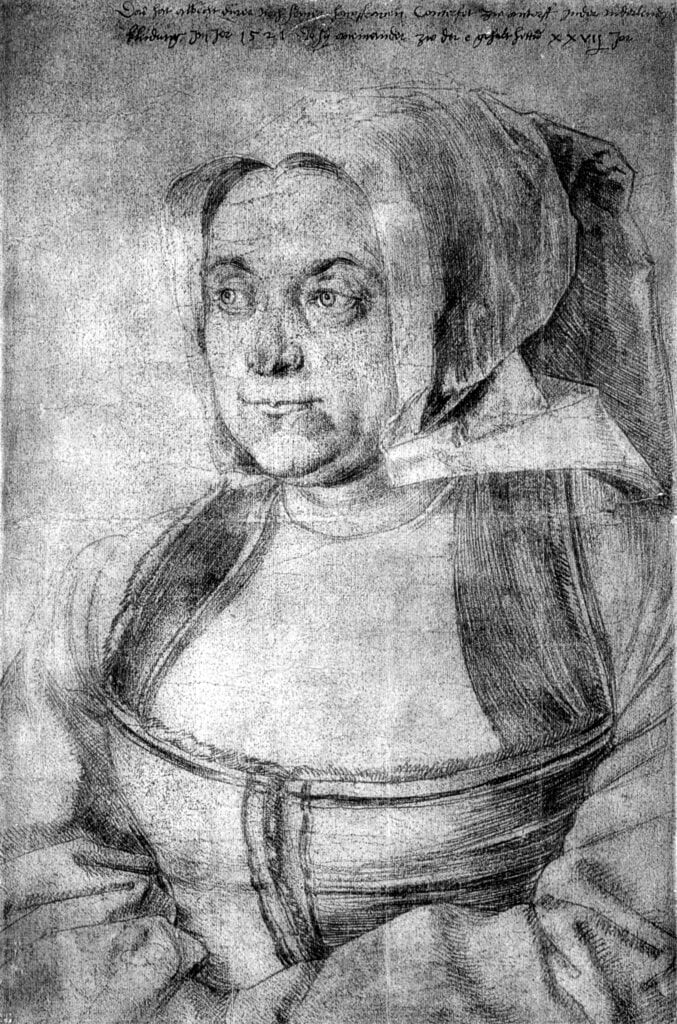
She and he were a domestic and business partnership, and she played a pivotal role in his life and career. She was the brains behind the business aspects of Dürer’s art, and is credited for managing the marketing and sales of his prints.
When Albrecht traveled, Agnes either went with him, or managed their workshop, ensuring the continuity of their business, and held down the fort in all aspects. Dürer, even in his own lifetime, was more than just an artist – he was a brand, and she was the brand manager.
Upon his death, she was the sole inheritor of his works, and continued to sell copies of his prints and engravings in Nuremberg throughout her lifetime, ensuring their continued distribution.
There is much less known of her than of her husband, but Agnesgasse is a nod to her importance in his life, career, and in spreading his art and influence across Europe.
If you want to learn more of her life and significant contributions to Team Dürer, there’s an interesting tour of the Albrecht-Dürer-Haus Museum in which a costumed actor with the persona of Agnes Dürer will give you a guided tour of their home! Check the link for the days and times of English and German tours.
5) Dürer’s Stained Glass in Sebalduskirche (St. Sebald’s Church)
Winklerstraße 26, 90403 Nürnberg
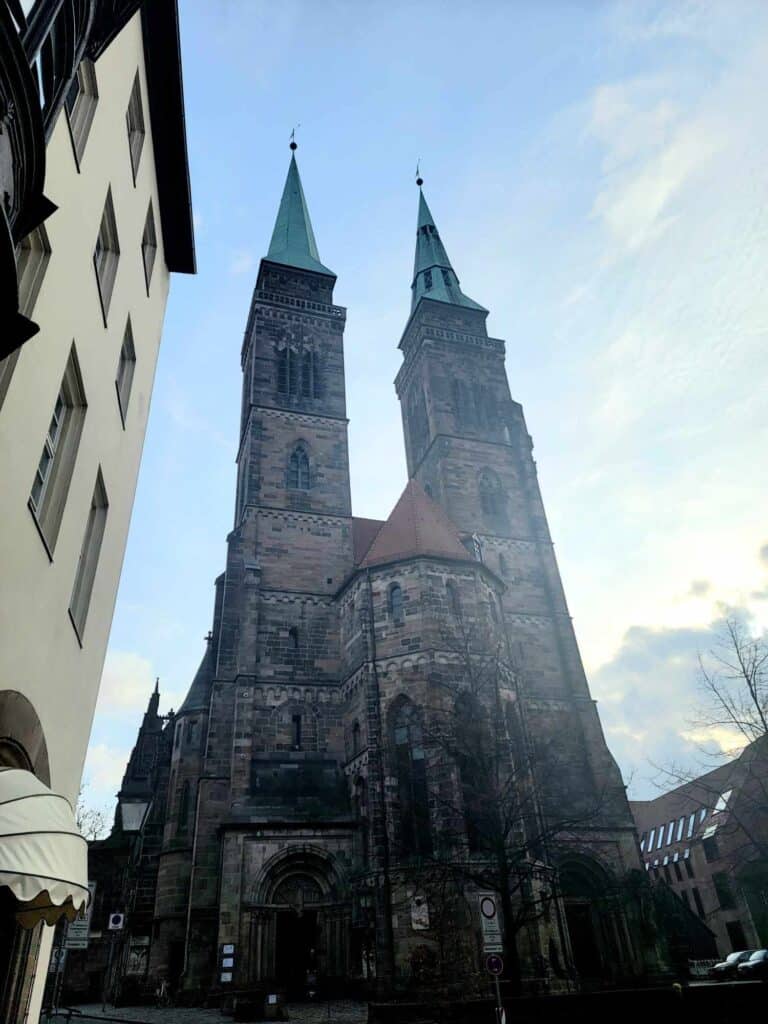
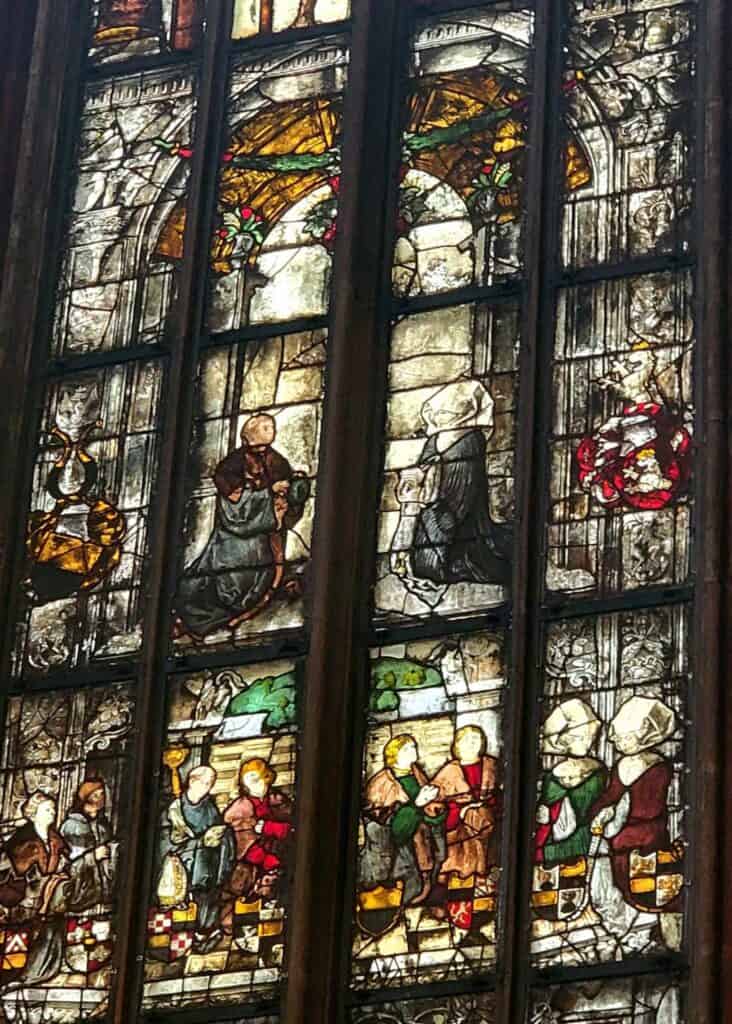
Dürer’s art in St. Sebaldus Church has one of the most fascinating stories of all the Albrecht Dürer sites in Nuremberg!
In the east choir (far side on the left as you enter) a stunning set of stained glass windows designed by Dürer can be found. These windows are some of his few remaining religious works in Nuremberg.
If you’re wondering how on earth these fragile and ancient stained glass windows survived the devastating bombing of Nuremberg during World War II, you can thank those who had the foresight to painstakingly remove the glass panels (and many other artworks in the church) in advance of the destruction.
They did so at some risk because by removing them, they were acknowledging that the Germans might not win the war, and that Nuremberg was vulnerable. Nevertheless, they did the work and saved these precious works for future generations.
Dürer’s windows, along with the hundreds of other artworks in the church and around the city were meticulously and carefully packed, transported down the street, and hidden away in a network of subterranean tunnels which had previously served as beer cellars during medieval times.
After the war, the treasure trove was discovered by American soldiers in August of 1945, and the artworks found their way back to their rightful places. Which brings us to…
6) The Kunstbunker (Art Bunker) Where Nazis Stashed Priceless Art
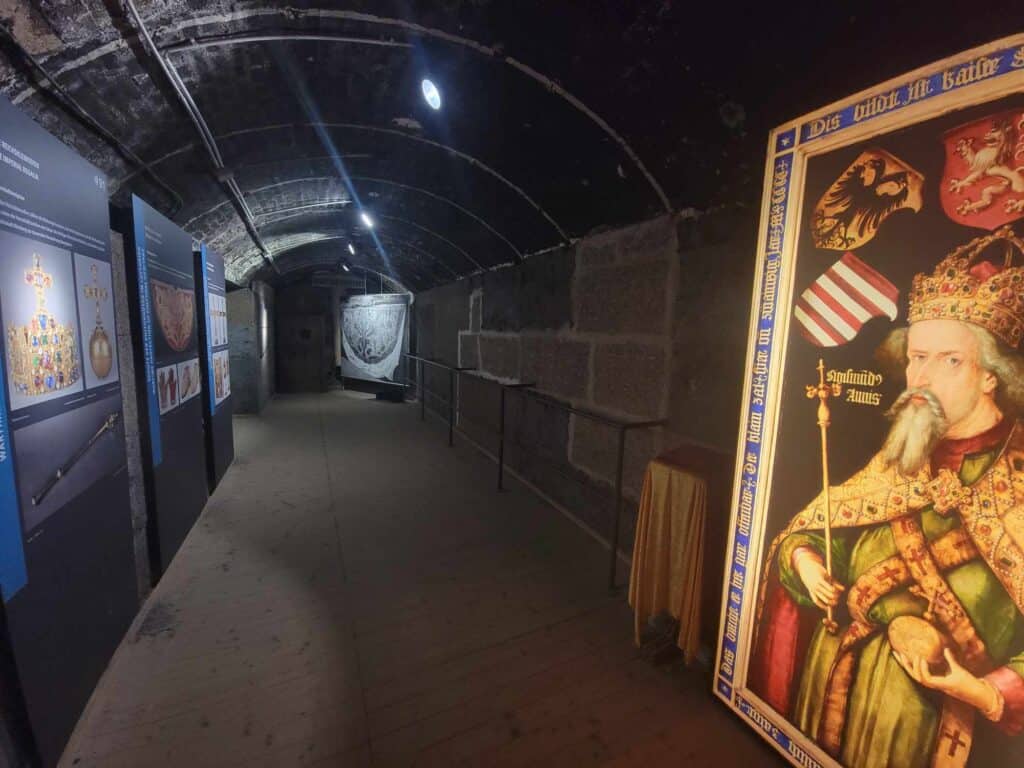
In my opinion, this is one of the most fascinating historical tours you can take in Nuremberg! A guide will take you right into the tunnel network that was dug into the sandstone outcropping underneath Nuremberg Castle.
These tunnels were used in medieval times as beer cellars and would have been functioning in that capacity during Dürer’s lifetime. Little did he know that some of his artworks would some day be stashed there as part of the Nazi’s secret repository of stolen art!
When World War II began to turn in the Allies favor, a mass movement of precious artworks began. Everything from the Dürer windows, paintings and engravings, to statuary from Sebalduskirche and Lorenzkirche, and plundered artworks from across Europe (like the famous golden Veit Stoss altarpiece from Krakow, Poland, and even the Imperial Crown of the Holy Roman Empire made its way into the tunnels.
Do yourself a favor and don’t miss this tour. Not only for an interesting piece of Dürer history, but for history in general, it’s a winner.
You can read more about the Kunstbunker here: The Nuremberg Art Bunker and its Dark Secrets.
7) Dürer’s Famous Animals in Nuremberg
The “Young Hare” (1502)
Dürer’s “Young Hare” (Feldhase) is, no exaggeration, one of the most celebrated animal studies in art history. Dürer created it in 1502, just a year before DaVinci began work on the Mona Lisa. Dürer’s watercolor is a masterpiece of technical skill.
Dürer, as many artists of the time, was fascinated with the natural world and he painted animals and plants with incredible precision during the time when the Renaissance brought the study of nature and science into higher regard.
The Young Hare has been reproduced, and copied, and riffed on in every way imaginable. You’ll see images of the Young Hare, and all kinds of variations of it throughout the city.
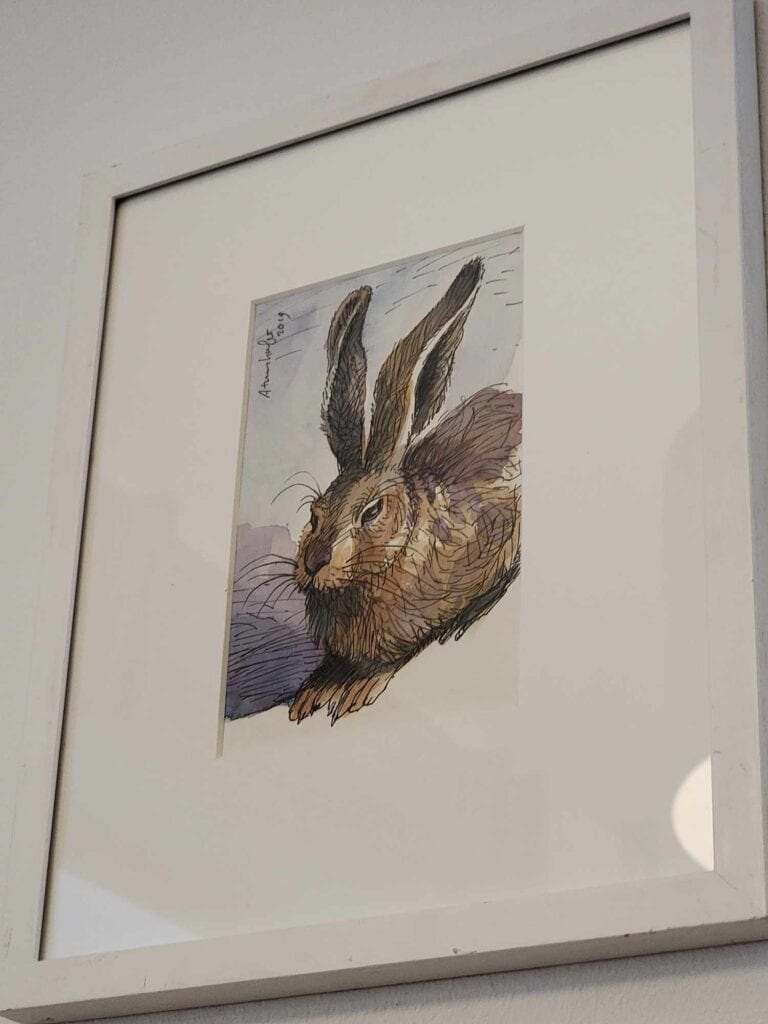


But to see the original “Young Hare” you’ll have to head to the Albertina Museum in Vienna, Austria, and you’ll also have to be very lucky. The Young Hare is rarely displayed due to its fragility, so copies will have to be enough for most of us.
The Meaning Behind the Giant Hare Outside Dürer’s House
In the square right outside the Albrecht-Dürer-Haus Museum, sits another rabbit – this one is huge and made of bronze. It isn’t a detailed and accurate study like the original. Some have even called it the “ugliest public art” in the country. Yikes.

This sculpture, “The Hare,” made in 1984 by artist Jürgen Goertz shows a bloated, deformed rabbit with giant bug eyes staring blankly into the distance while chewing on a pile of iron nails. It is breaking out of a box from which emerges a whole litter of smaller rabbits. And underneath the rabbit… someone has been crushed. You can see a hand and a foot sticking out from underneath the rabbit’s giant body.
So, what’s that all about? We don’t really know because the artist has not shared the meaning of the symbolism in the work. It’s been suggested it is a critique on the commercialization of art beyond recognition, and in particular Dürer’s famous hare.
The Nuremberg website says that, whatever the meaning, there was “an outcry when the rabbit was erected in 1984, because nobody liked it.” Whether you find it thought-provoking, or whether you’ll take a hard pass on the monster rabbit, you will definitely not miss it when you visit the Albrecht-Dürer-Haus Museum!
Dürer’s Iconic Rhinoceros
In addition to the giant rabbit sculpture, you’ll find another notable animal-themed sculpture just outside the city walls that pays homage to Dürer’s famous woodcut of a rhinoceros!
Dürer’s artwork, which depicted the rhino in a fantastical and wildly inaccurate way was based on reports from Portuguese sailors who had been part the journey to bring a rhinoceros from India back to King Manuel I of Portugal. Dürer also had the benefit of seeing a sketch of the animal by a German merchant who was in Lisbon and saw the rhino in person.
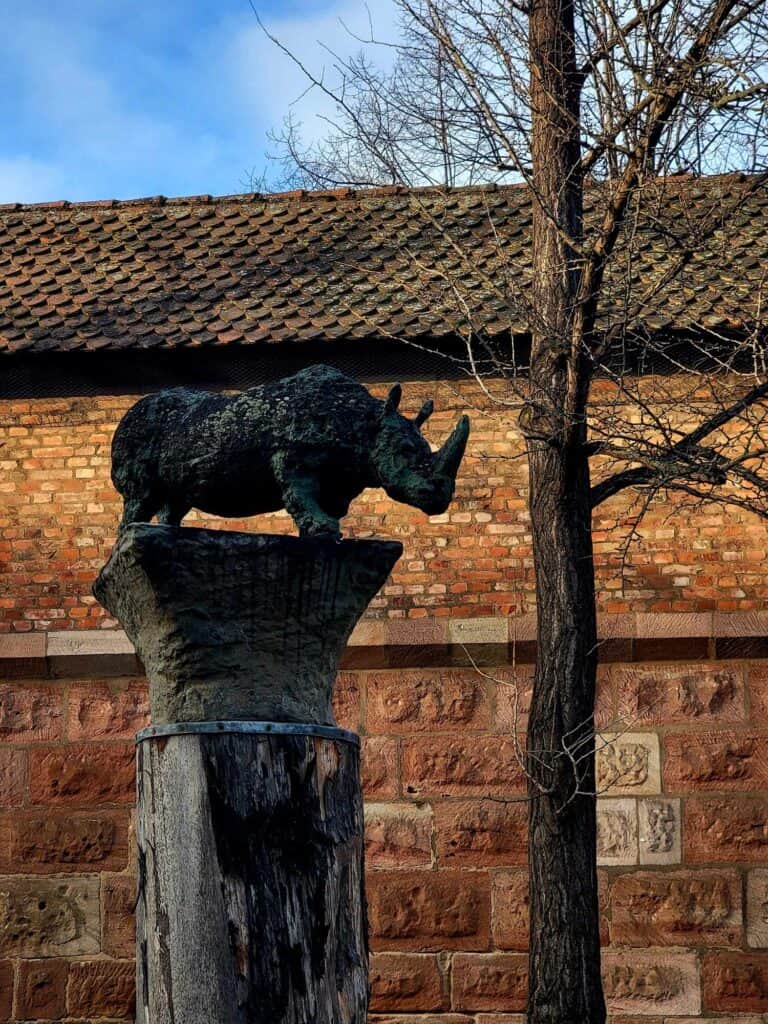
Medieval artworks where the artist never actually saw the animal in question can be hilarious. But leave it to Dürer to come up with a rhino that’s even better than the real thing! It’s intricate armour, and almost magical appearance sparked imaginations, and helped to create rhino fever in Europe. Most Europeans had never seen a rhinoceros in 1515, so they absolutely fell in love with this exotic and sensational animal, and Dürer’s woodcut itself.
Dürer’s interpretation was the “fake news goes viral” of its time. People believed this to be what rhinos looked like for centuries afterwards, and the creation cemented Dürer’s reputation as a masterful artist.
And yes, I got a big vinyl rhinoceros at the gift shop of the Albrect-Dürer-Haus, because how could I not? My dog was a little freaked out when I brought it back to the hotel!
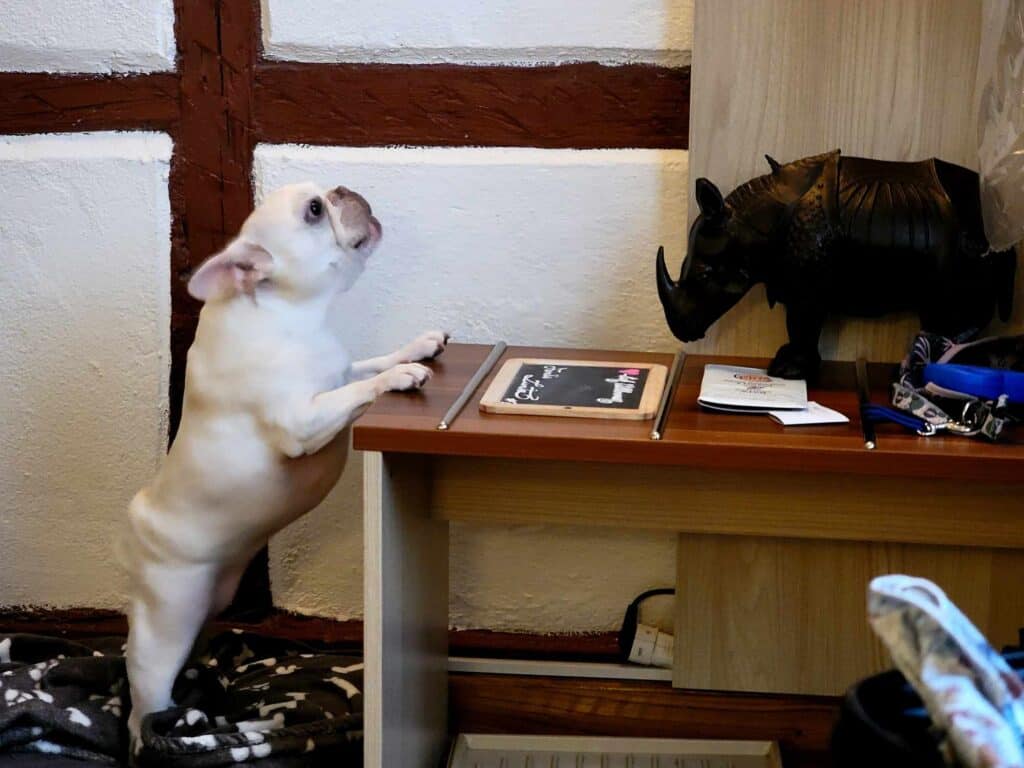
8) Nuremberg Castle
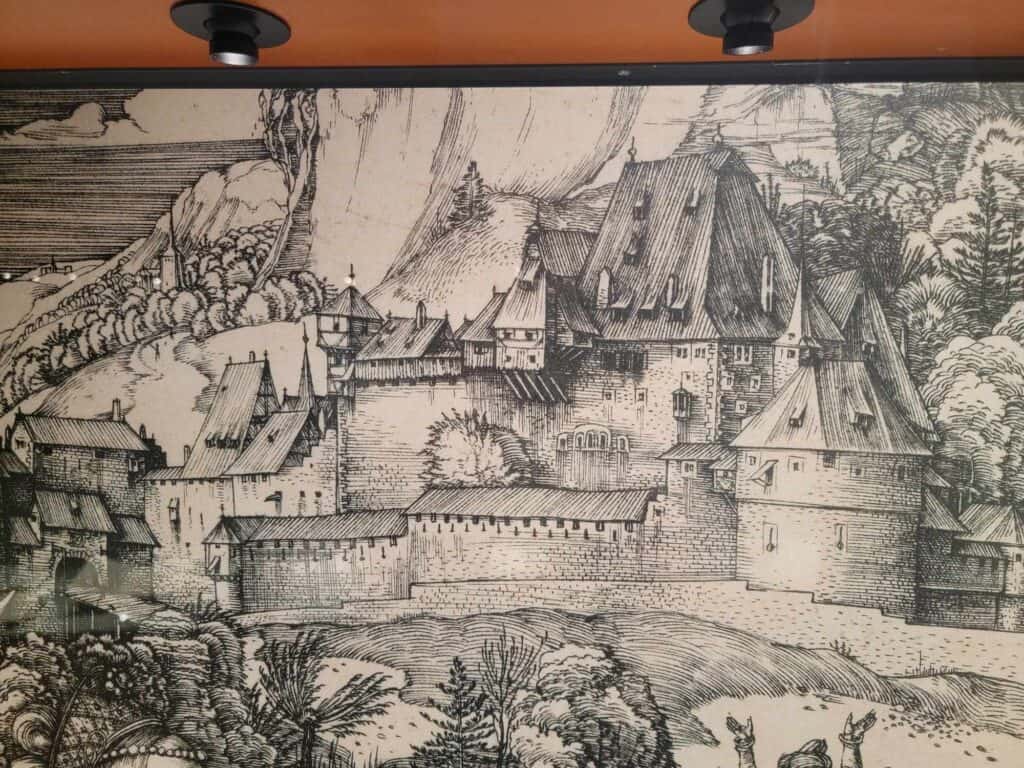
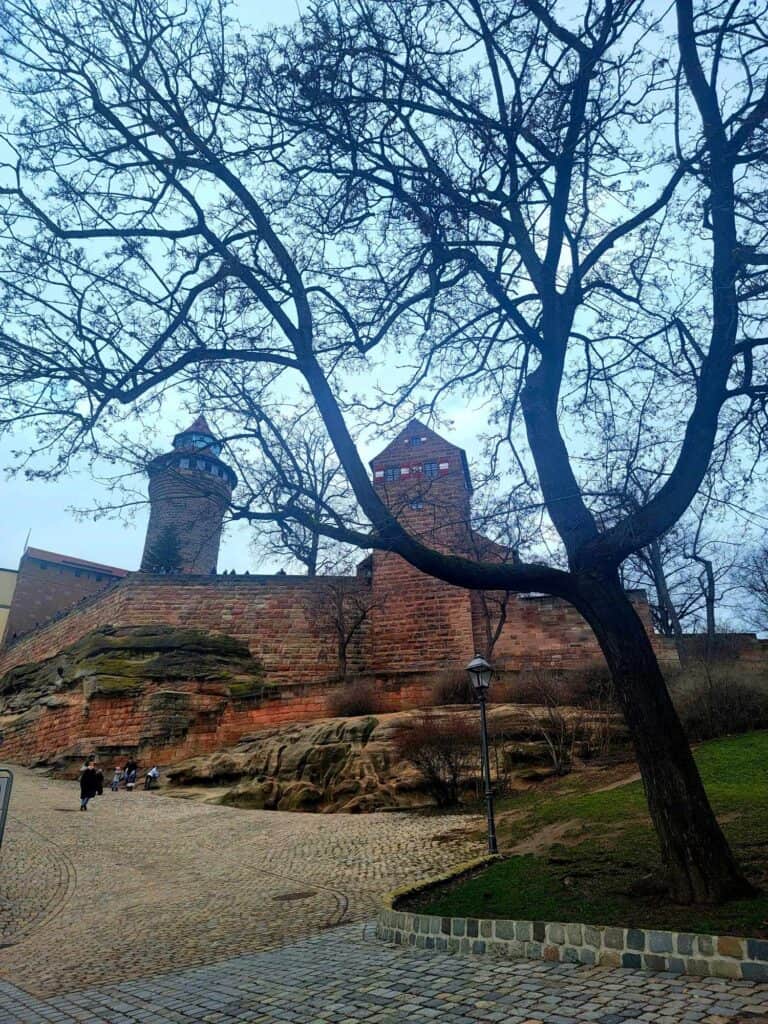
While the Nuremberg Castle itself does not house any of Dürer’s works, the castle’s proximity to Dürer’s studio means that he features the castle in his artworks, and it plays a significant role in understanding the city’s influence on his art. You can also see reproductions of Dürer’s depictions of the castle on display in the museum located inside the castle.
For more details on how to visit the Nuremberg Castle and what to expect there, check out: Your Ultimate Guide to Visiting Nuremberg Castle: History, Tips & Must-Sees.
9) The Site of Durer’s Childhood Home
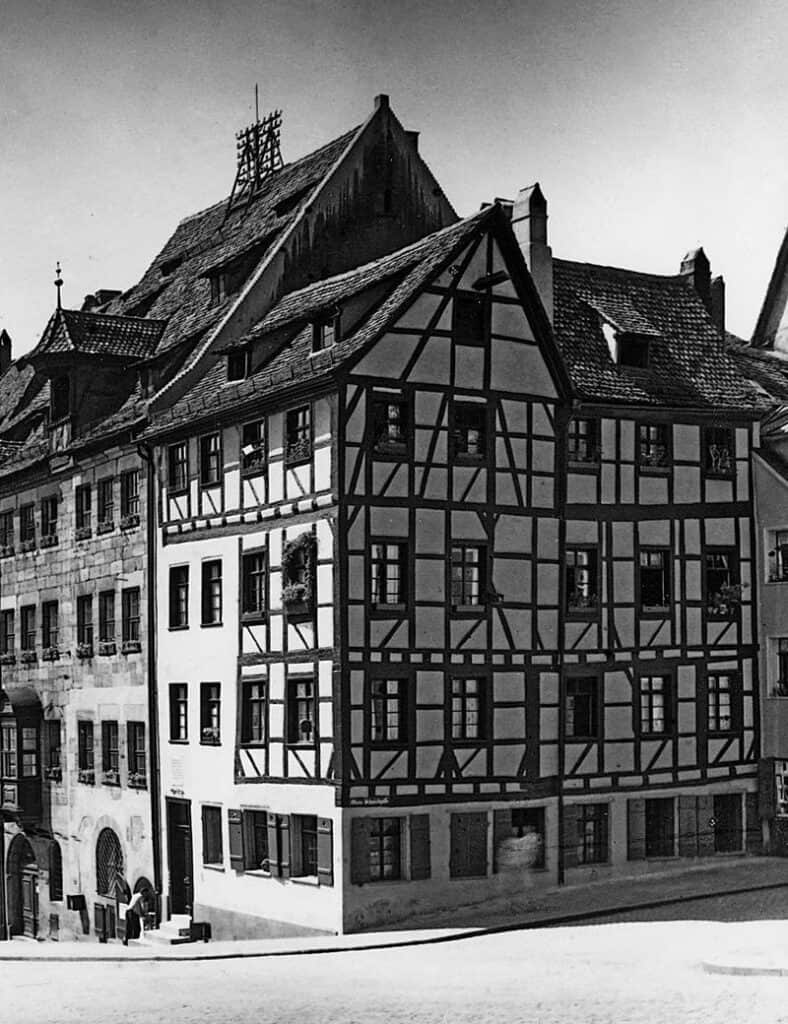
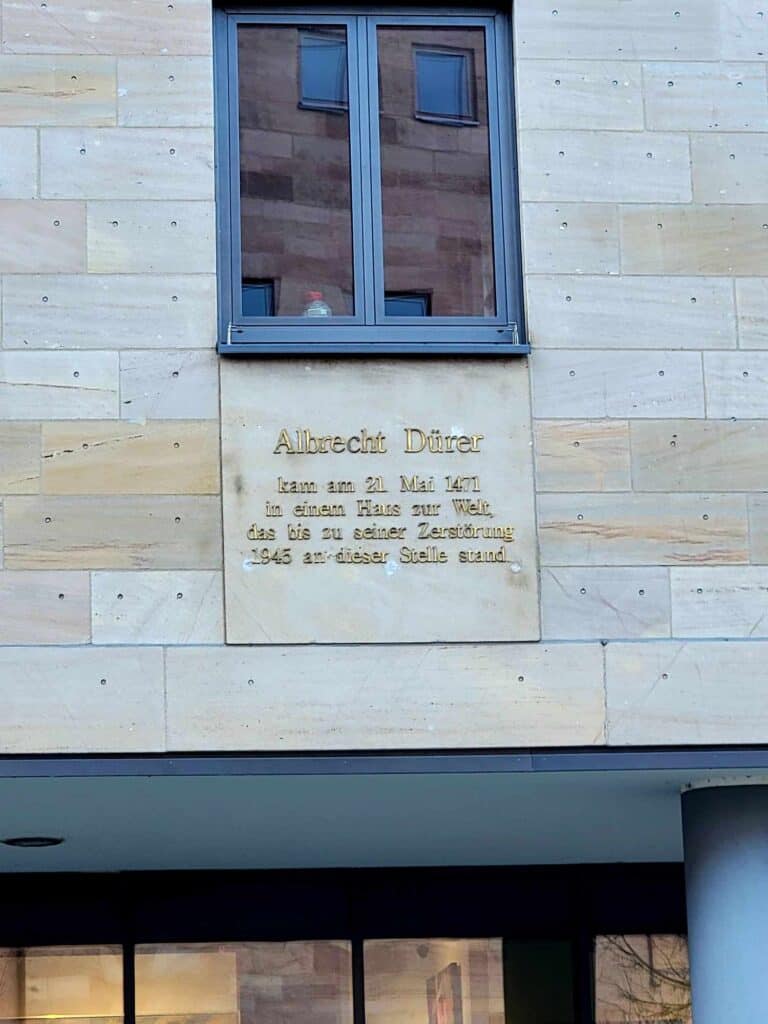
Albrecht Dürer was born on May 21, 1471. Historical records indicate that beginning in 1475, the Dürer family resided in their own house which was located at Burgstraße 27, an Eckhaus (corner house) of the Gasse unter der Vesten, known today as Obere Schmiedgasse.
We do have a photo taken of the house in 1933, but unlike Dürer’s later home which escaped bomb damage, his childhood residence was destroyed during the war, and a modern building which encompasses the former Burgstraße 27 and also Burgstraße 25 sits in its place.
There is a commemorative plaque which reads: “Albrecht Dürer was born on the 21st of May 1471 in a house that stood on this site until its destruction in 1945.”
10) Visit Albrecht Dürer’s Grave in Nuremberg
Johannisstraße, 90419 Nürnberg
On a trip with Agnes to the Netherlands in 1521, Dürer had became ill and struggled with recurring fever and bouts of illness for years. Many speculate he had contracted chronic malaria which took a serious toll on his health, and significantly reduced his artistic output in his final years. He eventually succumbed to the disease on April 6, 1528. He was 56 years old.
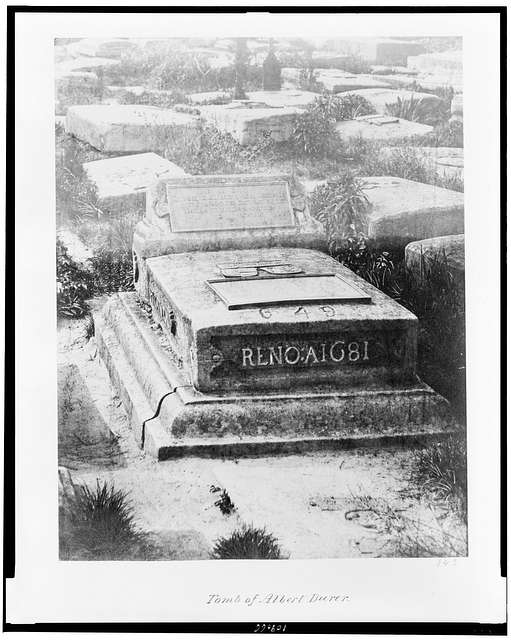
The city mourned the passing of the great master, and he was laid to rest in Johannisfriedhof (St. John’s Cemetery) in Nuremberg. You can visit the cemetery and his grave today.
The cemetery is a fascinating and beautiful place. It was created in the early 1500s after the Town Council prohibited any more burials within the town walls, and it contains many old and interesting gravesites.
Dürer’s friend Willibald Pirckheimer penned his tombstone’s epitaph, ‘What was mortal of Albrecht Dürer lies beneath this mound’.
Dürer is Everywhere – His Connections to the Cityscape
Today it is evident that Nuremberg has never ended its love affair with its most famous son. His name appears all over the city, and images of his artwork are ubiquitous.
There’s Albrecht-Dürer-Straße, formerly known as Zistelstraße before being renamed to honor the artist; the Dürer-Gymnasium Nürnberg is a secondary school in the city; there’s Albrecht-Dürer-Platz in the heart of the Old Town; and even Nuremberg’s airport bears his name.
The places that had meaning in his life are remembered and preserved when possible, and as long as Nuremberg stands it will hold the legacy of Albrecht Dürer with reverence as part of its cultural identity.
I hope you’ve enjoyed this guide to the best Albrecht Dürer sites in Nuremberg, and utilize it to create your own self-guided tour of these historical and fascinating places!
You may also like:
- 25 Best Things to Do in Nuremberg: History and Hidden Gems
- Your Ultimate Guide to Visiting Nuremberg Castle: History, Tips & Must-Sees
- The Nuremberg Art Bunker and its Dark Secrets
- Hotel Elch: Best place to Stay in Nuremberg with a Dog
- 46 Best Things to Do in Rothenburg ob der Tauber
- One Day in Bamberg: Best Guide to Germany’s Medieval Beer Capital
